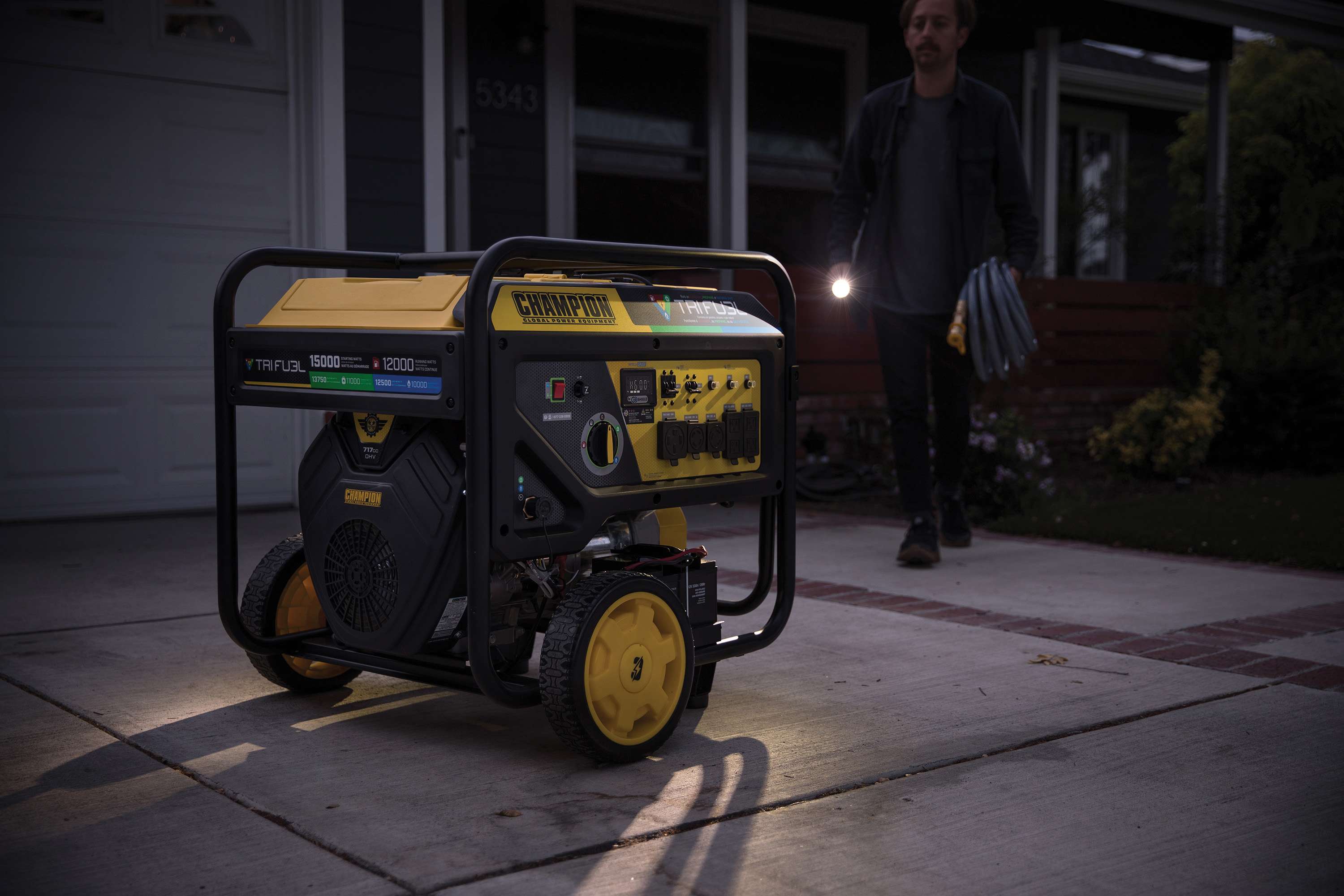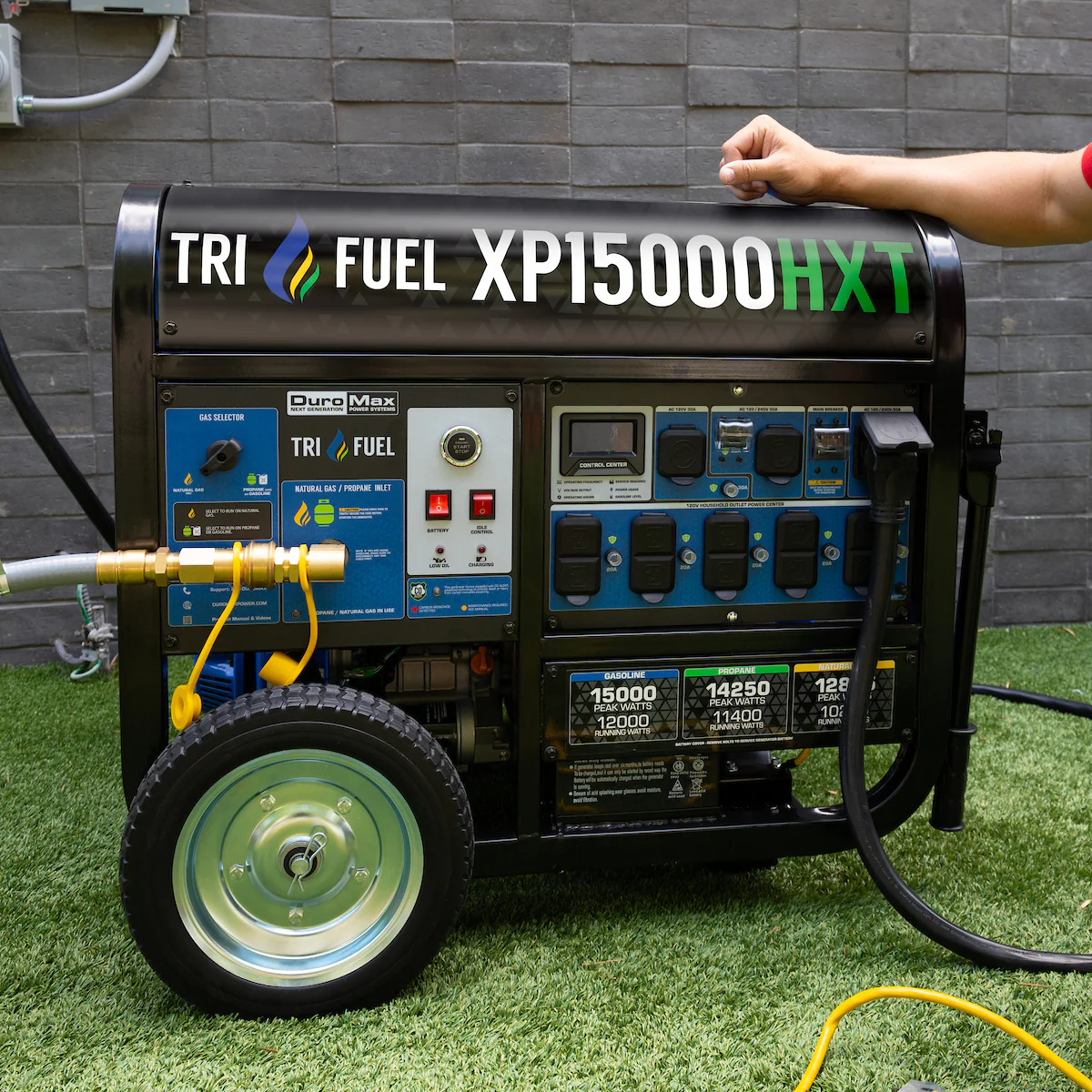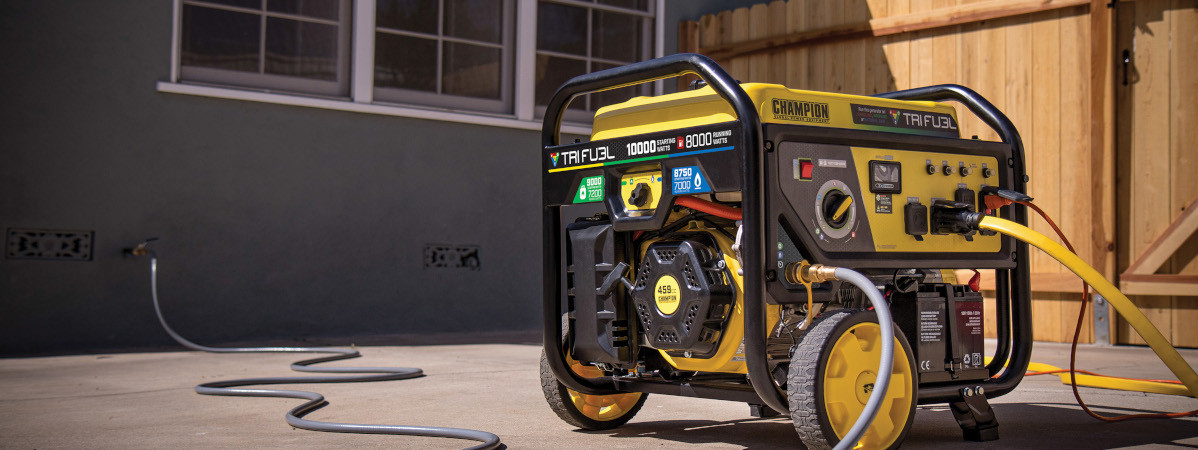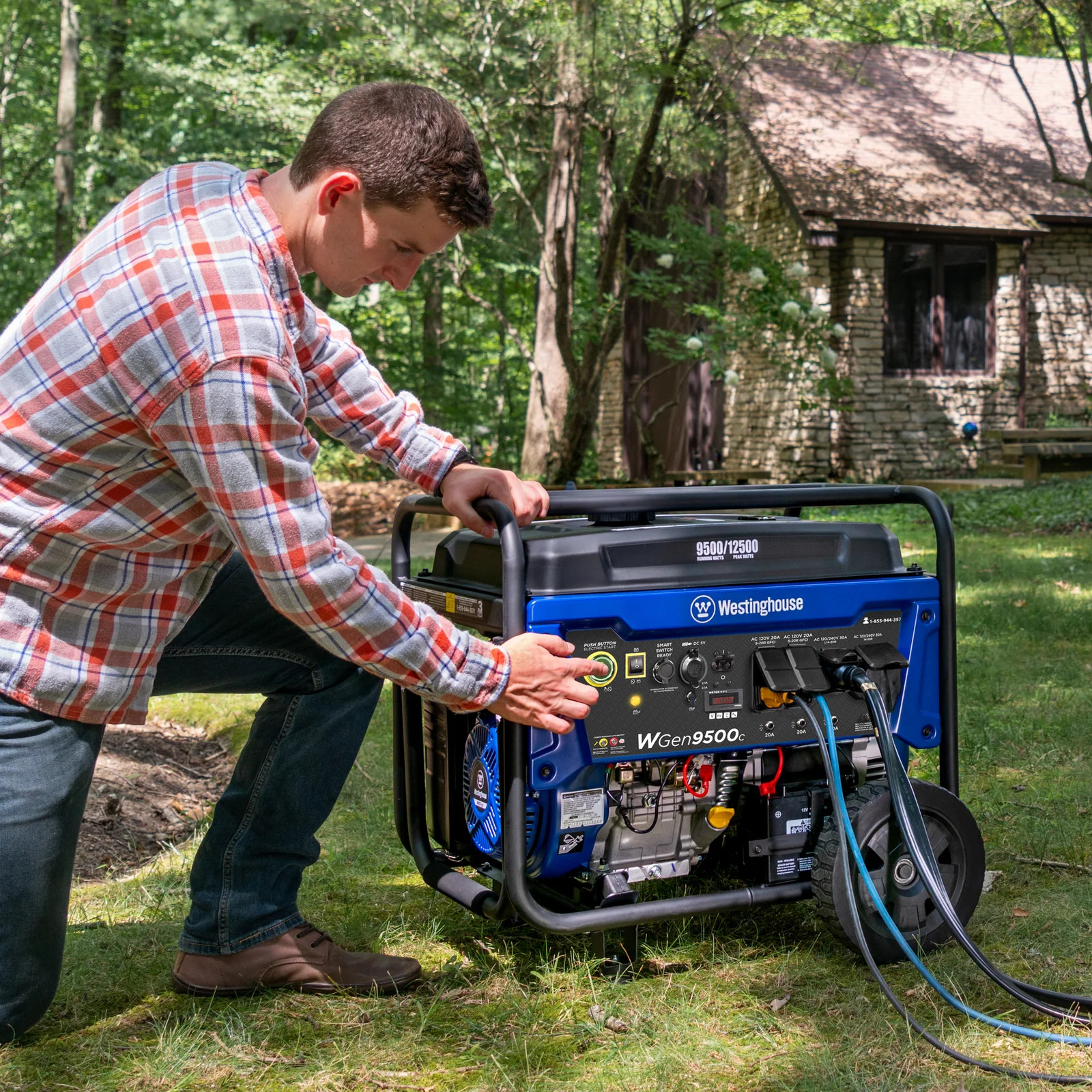Pick the Best Portable Generator for Home Use

Portable Home Generators
The need for backup home power grows annually with hurricane disasters, blackouts, winter storms, and derechos causing an increasing number of outages. Every year, millions of utility customers experience power outages that last from minutes to days. Following a hurricane or derecho, it can take weeks to fully restore power to a devastated region. Stay Safe During a Power Outage.
Essentials that Need Power During an Outage:
- Refrigerator
- Freezer
- Sump Pump
- Lights
- Medical Equipment
- Well Pump
- Furnace
- Air Conditioner
You may not need to supply all these appliances with power during every outage and you might have other critical circuits or appliances that you want or need to power.
How to Use a Portable Generator for Home Backup in an Power Outage
How Big of a Generator Do I Need

Common appliances and circuits that homeowners need most during a power outage.
| Appliance / Circuit* | Running Watts* | Starting Watts* |
|---|---|---|
| Refrigerator | 900 | 1800 |
| Freezer | 900 | 1800 |
| Sump Pump | 500 | 1700 |
| Forced Air Furnace | 600 | 1600 |
| Small Window Air Conditioner | 720 | 2160 |
| Kitchen Appliance | 1500 | 1500 |
| Microwave | 1000 | 1000 |
| Lights- LED 100 Watt Equivalent | 13 Watts Each | 13 Watts Each |
| Internet Router | 20 | 20 |
| Television- 60 Inch LED or OLED | 90-120 | 90-120 |
| Total | 6390 Watts |
*Examples. Your needs, appliances, and power requirements may be vary different from these.
Manufacturers rate Portable Home Generators in watts.
- Running Watts = how much power the generator can supply continuously.
- Starting Watts = the power a generator can supply over 1-3 seconds to start a motor. (Also referred to as surge watts or max watts)
Basic Generator and Motor Math
- Watts (W) = Volts (V) x Amps (A). Nearly all appliances have a required tag with electrical information.
- Kilowatts (kW) = Watts (W) / 1000. (1000 Watts = 1kW)
Calculating power and determining minimum generator capacity required.
- Make a list of the appliances / circuits you need during an outage with running watts and starting watts. (See table above)
- Total the running watts for each appliance you want to run during an outage.
- Add 25% to the total running watts.
- Add the highest starting watts from your list to the total.
- Add the starting watts of any additional motor loads that might start frequently, like a sump pump.
- This is the smallest generator you should consider purchasing.
Why add 25 percent? In practice, it’s better to have a little margin, usually 20 to 30 percent, especially for a house.
- It’s hard on a generator to run it at maximum capacity for extended periods.
- You might have to run something you didn’t plan to run.
- An appliance might use more power than expected.
Some appliances have motors that start and stop frequently, while others only start a few times a day. A chest or upright freezer that is at least half full may only run once a day. During and after a storm, the sump pump may start and run every few minutes. The compressor on a window air conditioner might turn on and off frequently.
If two motors start at the same time, and your generator does not have the capacity to start both, the overload could force the generator circuit breaker to trip. A sump pump is critical to maintaining the safety of your home. If you use another appliance that starts and stops frequently, add the starting watts for that item to the minimum max watts your generator must supply.
Choose a generator that can supply the running watts with enough surge watts for the appliance that needs the most surge watts.
Portable Generator Sizing Guide
In the Appliances and Circuits table above, with 10, 13 Watt LED lights (100 Watt Equivalent,) the total is 6390 Watts.
- 6390+25%=7988 Running Watts
- 7988 + Highest Starting Watts = 7988 + 2160 = 10148 Watts
- Select a generator with at least 7988 Running Watts and 10148 Starting Watts.
Accommodate Frequently Starting Loads
- If the home has a sump pump (or other motor, perhaps a well pump) that starts and stops frequently
- Add that load's starting watts to the total running watts.
- In our case: 7988 + 1700 (sump pump) = 9688 running watts
- add the highest starting watts. 9688 + 2160 = 11848 Starting Watts.
Armed with this information, we select a generator with at least 9688 Running Watts and 11848 Starting Watts.
Often, the difference between the required running watts and starting watts works out to purchasing a generator with higher running watts than our calculation indicated.
However, we can also give a little in the other direction. We included a 25 percent margin, but our criteria called for 20 to 30 percent. If we adjusted down just a little, we can see that 9500 Watt generator will also work as it provides us with 22 percent margin. After checking various brands, we find a 9500 Watt Generator with 12500 Starting Watts. We check all the other specs and decide this is the generator we want.
Different fuels provide different amounts of energy. Natural gas has less energy than propane, and propane has less energy than gasoline. If you're considering a multifuel generator, choose a generator capable of providing enough power on ALL fuels, and not just gasoline.
Don't Miss Out on Savings and Deals. See Norwall's Referral and Rebate Center
Can a Portable Generator Run a Central Air Conditioner?
As you probably know based on your electric bill, a central air conditioner is a heavy electrical load. The bigger the A/C unit, the more power hungry it gets.
| Central A/C Size | Running Watts* | Starting Watts** |
|---|---|---|
| 1-Ton 12,000 BTU | 1750 | 3500 |
| 2-Ton 24,000 BTU | 2750 | 5500 |
| 3-Ton 36,000 BTU | 3750 | 7500 |
| 4-Ton 48,000 BTU | 4750 | 9500 |
| 5-Ton 60,000 BTU | 5750 | 11500 |
*Running watts based on (1000 Watts / Tons of Cooling Capacity) + 750 Watts for the furnace fan.
**Starting watts estimated as 2x the Running Watts, usually achievable with a motor soft starter installed.
Remember, your appliance tags will have correct information. These tables are for example only.
The starting watts on a heavy load like air conditioners will challenge most portables. However, a soft-start device installed by your HVAC professional can lower the starting watts to a manageable level. The additions of a load like this will require consultation with a licensed HVAC technician and an electrician.
Norwall has portable generators with the capacity to run an entire home, including a 4-5 Ton Air Conditioner. Be sure to consult a licensed electrician.
Power Calculator—How Big of a Generator Do I Need?
What Kind of Generator Do I Need

Portable Generators for Home Use fall into two basic categories: Standard Portable and Inverter.
Standard portables run at a constant speed of 3600 RPM to maintain a frequency of 60 Hertz. Ratings include models up to 18000 watts. As the power capacity goes up, the amount of noise also increases. Noise levels start around 68 dB—compare to an older central air conditioner.
Inverter portables vary their engine speed to meet the load requirement. This decreases noise and reduces fuel consumption. Noise levels start at 51 dB. At least one model runs up to 34 hours on a single LP Propane tank.
Total Harmonic Distortion (THD) THD refers to the degree of electrical signal distortion from a true sine wave. Although there are exceptions, most traditional portables produce higher harmonic distortion levels of 10-24 percent THD. Most inverter generators produce a nearly perfect sine wave output and have low Total Harmonic Distortion of less than 5%. Sensitive electronics, and newer appliances with electronics may refuse to operate on heavily distorted current and shut down. Uninterruptible Power Supplies are one example, though some have a generator mode to accommodate generator power.
Inverter vs Portable Generator. What's the Difference?
Lower capacity inverter generators are 120 Volt only. Larger capacity models operate at 120/240-Volts.
Choose a 120/240 Volts for Home Backup to help balance loads and connect through a transfer switch.
Inverter Generator Pros/Cons
- More fuel efficient than traditional portables
- Less noise than traditional portables
- Cleaner power than most traditional portables
- Run in parallel with a second inverter generator to produce up to 2x the power. —check for this capability. It allows you to run one generator when power needs are low, and two generators when power needs are high.
- Lower capacity inverter generators are 120-Volt only.
- Inverter generators cost more.
Features to look for:
- Gasoline provides the most power.
- Propane runs cleaner and stores longer, but produces less power
- Natural Gas equates to a virtually endless fuel supply but produces less power than propane.
- 120/240-Volt models can power hard-wired loads through a transfer switch.
- Get an electric start or remote start on larger generators.
- Fuel Gauge keeps you informed about fuel levels.
- Low Oil shutdown protects the engine if you run out of oil.
- Carbon monoxide shutdown helps protect against CO poisoning and death.
Should I Buy a Portable Generator for Home?
Portable Generator for Home Fuel Options

Portable Generator Fuel Choices
- Gasoline—Provides the most power.
- Limited storage.
- Limited shelf life.
- Obtain at local filling stations.
- Propane—Less power than gasoline.
- Storage limited to space for bottles or tanks.
- Unlimited shelf life.
- Obtain at local propane companies or exchange 20lb bottles at retailers.
- Large tanks eliminate refueling. Great for home backup solutions.
- Natural Gas—Less power than Propane
- No storage necessary.
- Unlimited supply unless shut off or cut off.
- No refueling. Excellent for home backup solutions.
Gasoline only models are a little cheaper than Dual Fuel or Tri Fuel options. The biggest advantage gasoline has over LP Propane and Natural Gas is power. As a fuel, gasoline carries more energy than either NG or LP.
For example, Champion rates the Tri Fuel 8000 watt generator for 8000 Running Watts on Gasoline, 7200 Watts running Propane, and just 7000 Watts using Natural Gas.
However, the tradeoff with a dual fuel or tri fuel model is the additional flexibility. LP Propane is easier and safer to store and it lasts longer than gasoline. Tank sizes are readily available in 20, 30, 40, and 60, and 100-pound sizes. You can also use a larger storage tank typical of those used for home heating and cooking.
An HVAC or plumbing company can install an adapter and valve for use with larger tanks or for use with your natural gas connection. Municipal Natural Gas offers a virtually unlimited fuel supply for extended run times.
Large propane tank sizes extend the run time before refueling. Don’t forget to check the generator oil daily and top it off as required, and to change the oil and filter according to the maintenance schedule.
Gasoline Generators for Home Use | Dual Fuel Generators for Home Use | Tri-Fuel Generators for Home Use
Portable Generator for Home Transfer Switch Connections

The safest, easiest, and most reliable connection between your generator and home appliances is the manual transfer switch. Instead of running multiple extension cords through windows, a transfer switch supplies power directly to the circuits you choose at installation.
Generator to Manual transfer switch connections require a generator with 120/240 Volt capability.
A generator cord plugs into the 30-Amp or 50-Amp receptacle on your generator. The other end plugs into the inlet box connected to your transfer switch.
You may NOT adapt a 50 amp generator outlet to supply a 30 amp transfer switch. The higher current will overheat the wiring and may cause a fire.
However, it is safe to adapt a 30-amp generator outlet to supply a 50-amp transfer switch because the current is lower than the inlet box amps rating.
When the power goes out, connect the generator to the inlet box. Start the generator and turn on the generator's main breaker. Shut off the transfer switch circuit breakers. Set the transfer switch to the generator position. Turn on your circuit breakers, starting with heavy loads first. Your essential and convenient circuits have power.
Manual Transfer Switch for Portable Generator
Updated October 26, 2024
